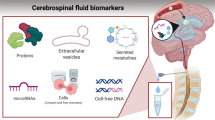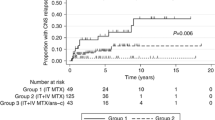Abstract
Eight patients affected by central nervous system tumours disseminating via cerebrospinal fluid received rIL-2 immunotherapy according to three different protocols involving intrathecal administration followed or not by systemic infusion. Immunological monitoring included serial evaluation of CSF leukocytes, CSF and peripheral blood CD3− CD56+ cells, and NK activity. The most marked rise in CSF leukocyte levels was induced by daily intrathecal rIL2 administration, which also induced increased PB NK activity. Systemic rIL2 infusion following intrathecal treatment maintained a high percentage of CSF CD3− CD56+ cells, but not CSF leukocytes at high levels. Clinical conditions improved after treatment in two patients, worsened in one and remained substantially unchanged in the remaining five. The side effects of intrathecal rIL2 treatment included fever, confusion, and seizures, and there were marked interindividual variations in the immunological response.
Sommario
8 pazienti con tumore del sistema nervoso centrale con disseminazioni via liquido cefalo-rachidiano, sono stati sottoposti ad immunoterapia con rIL-2 secondo tre diversi schemi di trattamento che contemplavano la somministrazione intratecale seguita o no da somministrazione per via sistemica. Sono stati valutati alcuni parametri immunologici tra cui: citometria liquorale, percentuale di cellule CD3− CD56+ ed attività Natural Killer (NK) sia nel liquor che nel sangue. Nonostante vi fosse una marcata variabilità interindividuale nella risposta immunologica al trattamento, il protocollo che procurava il più marcato aumento della citometria liquorale comprendeva la somministrazione intratecale giornaliera di rIL-2. Il trattamento con rIL-2 per via intratecale — a prescindere dallo schema di somministrazione — induceva un aumento dell'attività NK nel sangue. La somministrazione di rIL-2 per via sistemica, in seguito al trattamento intratecale, era in grado di mantenere una elevata percentuale di cellule CD3− CD56+ nel liquor, ma non di mantenere l'elevata citometria. Le condizioni cliniche erano, alla fine del trattamento, migliorate in due pazienti, peggiorate in uno e sostanzialmente invariate negli altri. Gli effetti collaterali del trattamento erano principalmente febbre, stato confusionale e convulsioni.
Similar content being viewed by others
References
Allen J., Hayes R., Da Rosso R. et al.:Intraventricular interleukin-2 (IL-2)/lymphokine activated killer (LAK) cells for leptomeningeal metastases (LM) in pediatric brain tumors. Proceedings of ASCO Vol. 12, 1993.
Elliott L.H., Brooks W.H., Roszman T.L.:Role of interleukin 2 (IL2) and IL2 receptor expression in the proliferative defect observed in mitogen-stimulated lymphocytes from patients with gliomas. JNCI, 78: 919–922, 1987.
Elliott L.H., Brooks W.H., Roszman T.L.:Inability of antigen-activated lymphocytes obtained from patients with malignant primary intracranial tumours to express high affinity IL2 receptors. J. Clin. Invest., 86: 80–86, 1990.
Elliott L.H., Brooks W.H., Roszman T.L.:Suppression of high affinity IL2 receptors on mitogen activated lymphocytes by glioma-derived suppressor factor. J. Neurooncol. 14 (1): 1–7, 1992.
Hayes R., Moore E., Pierz D.M. et al.:Interleukin-2 (IL2)-inducible lymphokine-activated killer (LAK) activity arising in blood following IL2/LAK therapy into the CSF compartment. Proceedings of ASCO, Vol. 12: 296, 1993.
List J., Moser R.P., Steuer M. et al.:Cytokine responses to intraventricular injection of Interleukin 2 into patients with leptomeningeal carcinomatosis: rapid induction of Tumor Necrosis Factor α, Interleukin 1β, Interleukin-6, γ-Interferon, and soluble Interleukin 2 Receptor (Mr 55000 protein). Cancer Res., 52: 1123–1128, 1992.
Mapstone T., McMichael M., Goldthwait, D.:Expression of platelet-derived growth factors, transforming growth factors and the ras gene in a variety of primary human brain tumours. Neurosurg., 28: 216–222, 1991.
McMannis J.D., Fisher R.I., Creckmore S.P. et al.:In vivo effects of recombinant IL-2. I. Isolation of circulating Leu 19 − lymphokine-activated killer effector cells from cancer patients receiving recombinant interleukin-2. Immunol., 140: 1335–1340, 1988.
Merchant R.E., McVicar D.W., Merchant L.H., Young H.F.:Treatment of recurrent malignant glioma by repeated intracerebral injection of human recombinant Interleukin-2 alone or in combination with systemic Interferon-α. Results of a phase I clinical trial. J. Neurooncol., 12: 75–83, 1992.
Meyers C.A., Yung W.K.A.:Delayed neurotoxicity of intraventricular interleukin-2: a case report. J. Neurooncol., 15: 265–267, 1993.
Rosenberg S.A., Lotze M.T., Muul L.M. et al.:A progress report on the treatment of 157 patients with advanced cancer using lymphokine-activated killer cells and interleukin 2 or high-dose interleukin 2 alone. New Engl. J. Med., 316: 889–897, 1987.
Ruffini P.A., Rivoltini L., Silvani A. et al.:Factors, including transforming growth factor b, released in the glioblastoma residual cavity, impair acivity of adherent lymphokine-activated killer cells. Cancer Immunol. Immunother., 36: 409–417, 1993.
Salmaggi A., Dufour A., Silvani A. et al.:Immunological fluctuation during intrathecal immunotherapy in three patients affected by CNS tumors disseminating via CSF. Int. J. Neurosci., 77: 117–125, 1994.
Schiller J.H., Hank J., Storer B. et al.:A direct comparison of immunological and clinical effects of interleukin 2 with and without interferon-alfa in humans. Cancer Res., 53: 1286–1292, 1993.
Saris S.C., Rosenberg S.A., Friedman R.B. et al.:Penetration of recombinant interleukin 2 across the blood-cerebrospinal fluid barrier. J. Neurosurg., 69: 29–34, 1988.
Vitale M., Neri L.M., Comani S. et al.:Natural killer function in flow cytometry. II Evaluation of NK lytic activity by means of target cell morphological changes detected by right angle light scatter. J. Immunol. Methods, 121: 115–120, 1989.
Yoshida S., Tanaka R., Takai N., Ono K.:Local administration of autologous lymphokine-activated killer cells and recombinant interleukin 2 to patients with malignant brain tumors. Cancer Res., 48: 5011–5016, 1988.
Author information
Authors and Affiliations
Rights and permissions
About this article
Cite this article
Salmaggi, A., Dufour, A., Silvani, A. et al. Intrathecal immunotherapy in CNS tumors disseminating via CSF: preliminary evaluation using different treatment schedules. Ital J Neuro Sci 17, 267–276 (1996). https://doi.org/10.1007/BF01997785
Received:
Accepted:
Issue Date:
DOI: https://doi.org/10.1007/BF01997785




